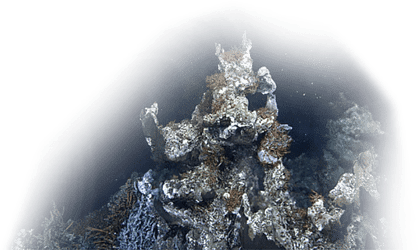Twice a year, every spring and fall, Ocean Networks Canada (ONC) heads to sea aboard the Canadian Coast Guard Vessel (CCGV) John Tully to maintain and upgrade ocean monitoring instrumentation in Saanich Inlet and the Strait of Georgia. Between 4 - 11 October 2016, in addition to the infrastructure maintenance priorities of the expedition, the ONC team also successfully deployed new instrumentation, carried out several activities in support of our science community, and collected samples for benchmarking and calibration of instruments.
The ONC crew aboard the CCGS Tully
Using acoustics to “see” marine life.
First among the new deployments was replacing the single frequency echo sounder at the Saanich Inlet instrument platform with a multi-frequency acoustic zooplankton and fish profiler, which uses three distinct acoustic transducers (38, 125 and 200 kHz frequencies) to effectively “see” marine life in the ocean. Large fish are detected using 38 kHz, medium-sized animals using 125 kHz, and microscopic zooplankton using 200 kHz.
The new multi-frequency acoustic zooplankton fish profiler, with three transducers: 38 kHz (centre), 125 kHz (right) and 200 kHz (left) transducers
By collecting all three frequencies together, researchers can attempt to quantify the abundance of each group, monitor fish and zooplankton variations, and their interactions. The over 10-year 200 kHz time series from this site will now continue with the addition of 38 and 125 kHz measurements, affording a better size-based discrimination between echoes (e.g. zooplankton versus fish). The plot is updated every day to show the previous day’s data.
Data from the newly deployed multi-frequency acoustic zooplankton and fish profiler in Saanich Inlet. The panels, top to bottom are: 38kHz, 125kHz, 200kHz, and a red-green-blue composite.
Monitoring underwater noise
A new hydrophone array was deployed as part of ONC’s Strait of Georgia underwater listening station. As part of a feasibility study in partnership with Vancouver Fraser Port Authority and JASCO Applied Sciences and with funding from Transport Canada in September 2015, ONC deployed an underwater listening station to monitor the ambient underwater noise in the Strait of Georgia. The project has successfully detected and classified marine fauna vocalizations (including orca, humpback whale, pacific white sided dolphin, and fish) and measured underwater noise from 2200 ships transiting to the port.
Deploying the new Vancouver Fraser Port Authority listening station in the Strait of Georgia.
In order to continue the study for an additional year, the ONC team retrieved the two tetrahedral acoustic arrays deployed in 2014 and replaced them with a single array. The underwater listening station has performed well and one array is all that is needed. Download listening platform recordings.
Understanding Turbidity
A new delta dynamics laboratory platform, designed by Gwyn Lintern and his team at Natural Resources Canada, was deployed. This is one of the largest platforms on the coastal network, measuring approximately six meters in length and equipped with over a dozen sensors and scanning sonars intended to provide a fuller picture of turbidity events.
Gwyn Lintern watches as the new delta dynamics lab is deployed in the Strait of Georgia.
As part of their ongoing research working with University of Victoria researcher Verena Tunnicliffe, Ryan Gasbarro and Jackson Chu joined the Tully in Saanich Inlet to conduct their thirteenth hypoxia transect since 2005. Using a remotely operated vehicle equipped with oxygen sensors, they have mapped the natural oxygen thresholds for dozens of species of benthic fish and invertebrates and documented the consequence of expanding hypoxia to how these animals are organized in hypoxic habitats. Read more about the extent of habitat compression and hypoxia in Saanich Inlet from the 2016 hypoxia cycle.
Jackson Chu (left) and Ryan Gasbarro (right) work with Denis Hedji, ONC’s Marine Equipment Specialist.
Science sampling was usually carried out at night after marine operations were completed for the day. The priority was to characterize the water column above and around the instrument platforms to benchmark oxygen sensors. The team also collected a cross-inlet section measuring conductivity, temperature, and depth (CTD) profiles in Saanich Inlet close to the inshore profiler in Coles Bay.
Night time science activities also included acoustic Doppler current profile transects in support of Rich Pawlowicz’s (University of British Columbia) ongoing efforts to describe mid-depth currents on the eastern side of the Strait of Georgia.
Stay tuned for our next inshore expedition scheduled for Spring 2017.
